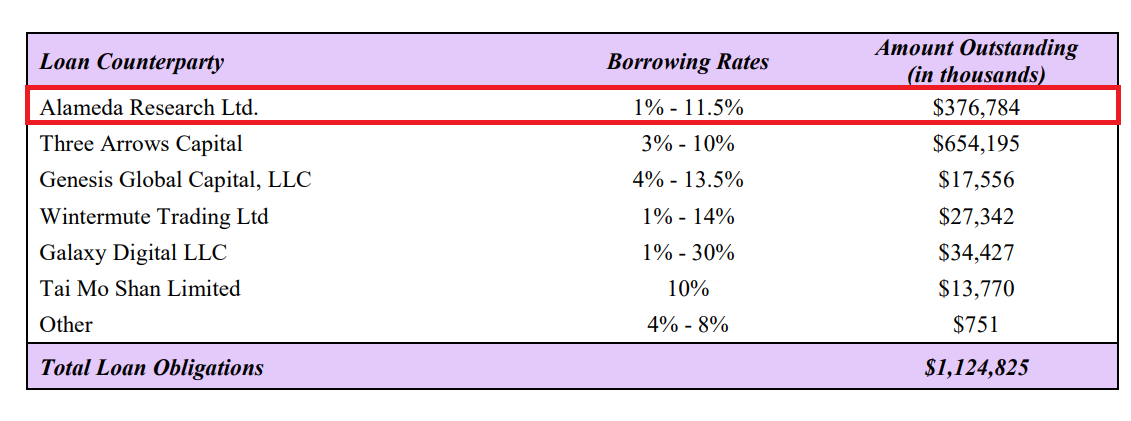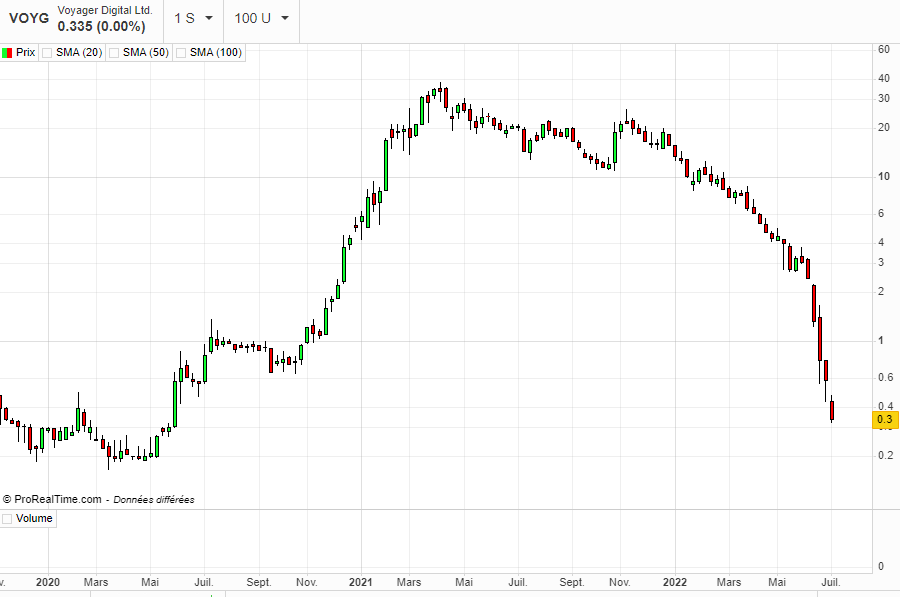A brief history of rescue
It all starts when, Last month, Singapore-based Three Arrows Capital (3AC), a highly leveraged crypto trading firm with $200 million exposure to the Luna cryptocurrency, disclosed that it was insolvent. To carry out its highly speculative trading operations, the company had borrowed colossal amounts from numerous companies in the crypto ecosystem including the broker Voyager Digital and the crypto lender BlockFi. Following the recent announcement of 3AC’s default, Voyager and BlockFi turned to the generous SBF to bail out the coffers. Or maybe SBF was already prowling under their feet to grab their next prey.
BlockFi, it’s quickly settled.
At the end of June, BlockFi announced that it had reached an agreement with FTX to be facilitated a $400 million line of credit, as well as a purchase option of up to $240 million in order to save in extremis the society that found itself on the edge of the precipice. As a reminder, a year ago, in the heart of the crypto bull market, BlockFi was valued at over $5 billion. A masterstroke achieved by SBF which “buy the dip” from BlockFi?
Turbulence at Voyager
The case of the recent bankruptcy of the crypto broker Voyager Digital is much more concerning than for BlockFi. The Canadian company did not survive the current market conditions and the insolvency of 3AC, of which it was one of the lenders. But why is this more worrying for SBF?
Almeda Research, a crypto investment fund and market maker founded in 2017 by SBF, is a borrower, lender and investor in Voyager. In its lender cap, Alameda facilitated $485 million under a line of credit it offered to the platform last month, from which Voyager drew $75 million, the maximum amount allowed over a 30-year period. days. An unsecured loan, according to Voyager’s list of largest unsecured debts.
Unsecured Claims for the Voyager Bankruptcy
Source: Bankruptcy filing in New York District Court
With its borrower hat, the SBF company owes the broker $376.8 million on a loan with an interest rate ranging from 1 to 5%. And with its status as a borrower, Alameda is required to repay Voyager despite filing for bankruptcy.

Voyager Borrowers
Source: Bankruptcy filing in New York District Court
Alameda’s debt makes it Voyager’s second largest borrower after the insolvent Three Arrows Capital. Finally, with its investor cap, Alameda holds a 9.5% stake in Voyager. It is not often that a borrower-shareholder bails out its lender.
Note that in 2021, Voyager Digital, listed on the stock exchange, had a valuation of more than 3 billion dollars. Today, its market capitalization is $48 million, or 98.4% lower. Hard blow for shareholders.

Zonebourse
The multiple hats endorsed by Alameda represent well the incestuous activities practiced by the giants in the crypto ecosystem and the “recycled capital” which sometimes masks the financial health of these entities. These sprawling networks deployed by certain companies inevitably have the effect of leading to significant economic exposures, thus exacerbating the risk of interconnection between market players.
FTX: JPMorgan 3.0?
One could allude to this situation in relation to what JP Morgan did during a financial crisis of 1907. JPMorgan, the American banker, at the time bought up the shares of companies in difficulty in an attempt to stop the collapse of businesses in the financial crisis of 1907. He was best known for reorganizing them and making them more profitable and stable. He is also known for reorganizing major railroads and financing industrial consolidations that formed General Electric, U.S. Steel, and International Harvester. Like JPMorgan, Bankman-Fried is somehow taking advantage of the crypto chaos to expand its empire.
But the FTX and Alameda boss is particularly selfless in the media, telling Forbes that “We’re ready to get a bad deal here, if that’s what it takes to stabilize things.” A stabilization which cost him, between the BlockFi affair and the Voyager affair, 750 million dollars in lines of credit and nothing for the moment indicates that the billionaire will see the color of this money again.
Recall that before this episode of crisis, SBF, through its FTX platform, recently accumulated a 7.6% stake in Robinhood with rumors of an upcoming acquisition. He also facilitated a $120 million loan to Japanese crypto exchange Liquid Group in August 2021, and bought the company out in February. We can also cite the acquisition of the Blockfolio application ($150 million) and the Ledger futures exchange in 2021. Not to mention all the stratospheric acquisitions in the sports world: acquisition of the naming rights for the the Miami NBA until 2040, official sponsor of Major League Baseball or the signing of a contract with the Formula 1 team, Mercedes-AMG Petronas. He has a heavy hand, SBF.
But where will the crypto-billionaire stop?
Let’s be reassured, SBF still has its eyes in front of the holes. He recently said that: “Some companies are fundamentally too far behind and it is impractical to support them for reasons such as a large hole in the balance sheet, regulatory issues or not having much money left. businesses to save,” but declined to name specific crypto exchanges. As a reminder, in January, FTX unveiled FTX Ventures, a $2 billion venture capital fund focused on digital asset investments, which it has since used to help bail out cash-strapped businesses, while Bankman-Fried, which made billions in cryptocurrency arbitrage beginning in 2017, said it has used its own cash to prop up cryptocurrency businesses. in trouble when it “didn’t make sense for FTX to do so.”
But the crypto billionaire is also on the front line of the political fight. His $5.6 million contribution to Joe Biden’s presidential campaign made him one of the biggest Democratic donors of the cycle.
The 30-year-old young American-crypto-billionaire ($8 billion in the bank account according to the Bloomberg Billionaires Index) has not ceased to amaze and will most likely remain one of the most influential people in the cryptocurrency sector. In the coming years. On the other hand, the multiplication of risky bets could cost SBF and its various companies dearly if the market continues to falter downward.
